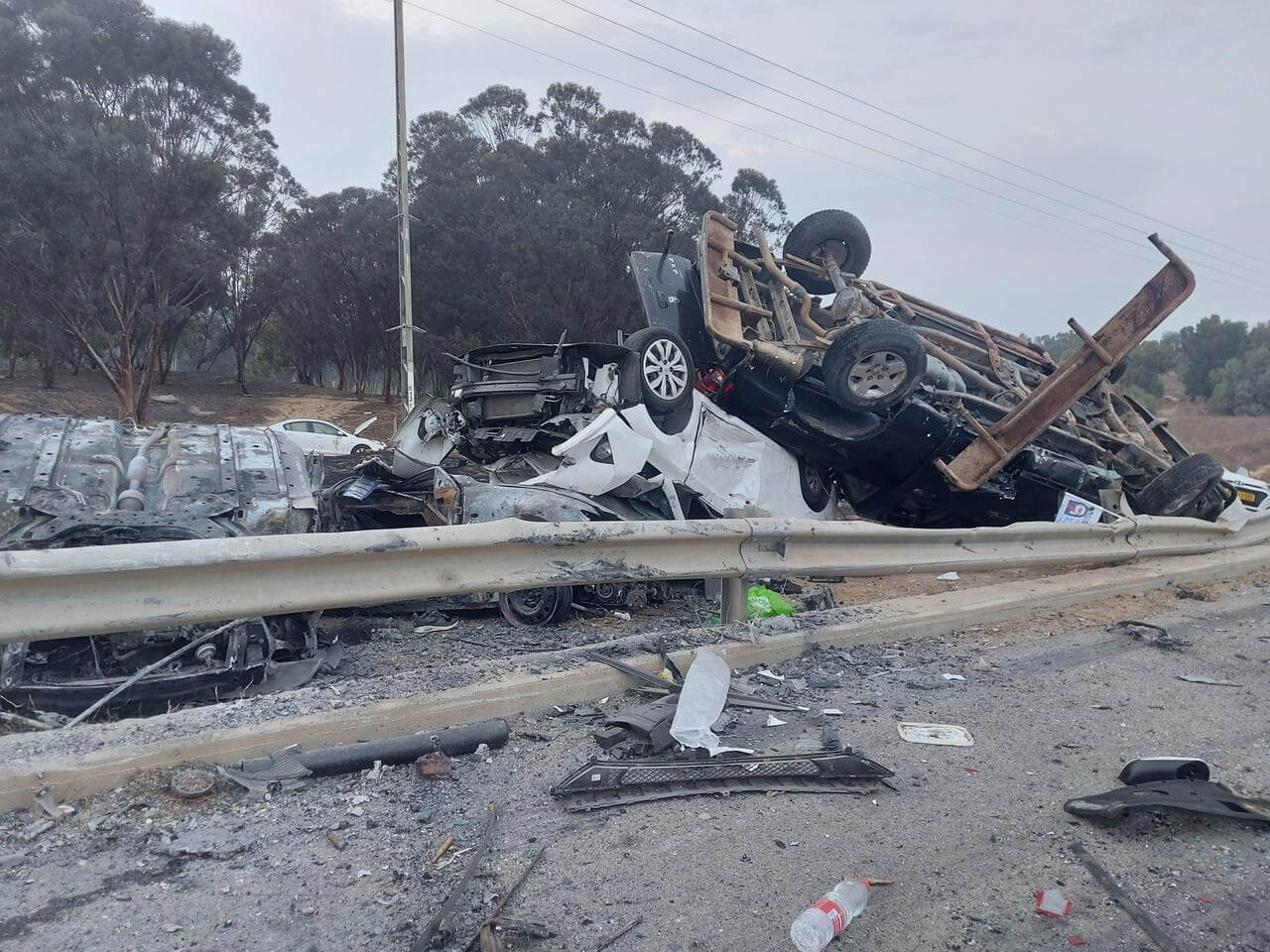Scene of Hamas attack on outdoor rave in Israel reveals grim evidence of how slaughter unfolded
The death toll from the party has surpassed 250, and the desperate search for the missing continues amid burned cars, thousands of scattered bullet casings, personal effects, and an overwhelming scent of blood

Burned-out cars near Kibbutz Re’im on Oct. 8, 2023, after a Hamas attack. Photo by Nir Hasson/Haaretz
This article originally appeared on Haaretz, and was reprinted here with permission. Sign up here to get Haaretz’s free Daily Brief newsletter delivered to your inbox.
The October 7 attacks had more than one ground zero. Among the most horrific was the woods near Kibbutz Re’im, where an outdoor rave came under attack by Hamas. Visiting the scene on Sunday, a day and a half after the carnage, the sights were almost indescribable.
A kilometer-long stretch of land is filled with hundreds of burnt and bullet-riddled cars, huge, foul-smelling bloodstains swarming with flies, body bags, thousands of bullets and casings and ammunition, and bodies – all, according to the Zaka rescue organization, those of Hamas terrorists.
The remains of at least 250 Israeli victims had been removed from the nightmarish scene earlier in the day, Zaka said. Scattered all over were personal items: tents, sleeping bags, backpacks, and empty bottles – the remnants of a party.
Over the course of the day, Zaka personnel collected the remains of Israeli victims. The terrorists’ corpses remained scattered around the area, some of them burnt, and the rest just lying there and starting to smell.
What remains attests to how the horrific events unfolded. Like the other attacks in the country, the events began with the white pickup trucks carrying the gunmen. Early on Saturday, these trucks stormed in, sowing death and destruction all around.
A police car collided with one of the vans on a road near the entrance to Re’im. The windshield has been pierced by gunfire, and the occupants were likely killed. Three attackers’ bodies are scattered. Still in the truck are a box of ammunition and the snacks that the attackers brought with them.
Further down the road, we come across Yaniv Vaanunu of the moshav of Patish. Since Saturday afternoon, he has been a one-man search operation for the missing. Dozens of families have approached him, providing personal information about their loved ones to help him locate them.
“When the wounded arrived at the moshav, I started my car and headed out,” he says. “I helped evacuate nearly 400 people – first the wounded, then bodies at night. I got seven bodies out of there.”
On Sunday morning, a day after the massacre, he returned to look for the cars and personal effects of those who were still missing. He took pictures of parked cars, licenses, and ID cards and sent them to families.
One family sent him a screenshot of their daughter’s last cell phone location. After a short search, Vaanunu discovered a small concrete bomb shelter next to the bus stop at the kibbutz. All indications were that the shelter had become a terrifying death trap.
The odor of death and blood made entering a challenge. When Vaanunu tried, he instantly ran back out to throw up. He encountered a group of four Tel Aviv residents who had come to look for a party attendee, Lior Segev, and three others who were with her.
One of the four walked inside, covering his face with his shirt. He soon returned shortly with a handful of blood-covered cell phones. They went back in several times and took a total of 12 phones. The four attempted to clean off the blood and determine the devices’ owners.
The evidence suggested that at least 12 partygoers had been crammed into the tiny area and killed by grenades and gunfire. According to one of the searchers, a survivor escaped by playing dead.
Vaanunu cleaned and charged the phones, advising the missing persons’ families to try calling. By that evening, one family was on the way to pick up their loved one’s phone. Vaanunu also gathered IDs and licenses. In a Whatsapp group, relatives tried to make sense of the mangled documents.
More horrors await further down the road: hundreds of charred or turned-over cars are strewn over a dirt-paved parking lot, stretching on and on. Smoke still billows from the woods, and there are huge bangs, but the silent dread of the scorched parking lot is somehow louder.
A pile of heavy machine gun casings sits across from the lot, evidence that terrorists stood on the road and gunned down everyone in the parking lot. Further on, we encounter a motorbike that had been carrying two of the terrorists, their singed corpses next to it.
A military vehicle begins to clear the burned-out cars blocking the road. The road is full of soldiers and officers asking us to stay away, but confusion still prevails. One officer orders us to go to one side and another to the other.
Vaanunu says he’s never seen anything like what he has at this ground zero of bloodshed. “I don’t want to feel,” he says. “I try not to think.”
A message from our Publisher & CEO Rachel Fishman Feddersen

I hope you appreciated this article. Before you go, I’d like to ask you to please support the Forward’s award-winning, nonprofit journalism so that we can be prepared for whatever news 2025 brings.
At a time when other newsrooms are closing or cutting back, the Forward has removed its paywall and invested additional resources to report on the ground from Israel and around the U.S. on the impact of the war, rising antisemitism and polarized discourse.
Readers like you make it all possible. Support our work by becoming a Forward Member and connect with our journalism and your community.
— Rachel Fishman Feddersen, Publisher and CEO



























